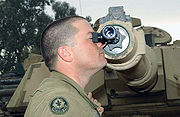
Boresight
Encyclopedia

Sight (device)
A sight is a device used to assist aligning or aim weapons, surveying instruments, or other items by eye. Sights can be a simple set or system of markers that have to be aligned together as well as aligned with the target...
, or iron sights, to align the firearm
Firearm
A firearm is a weapon that launches one, or many, projectile at high velocity through confined burning of a propellant. This subsonic burning process is technically known as deflagration, as opposed to supersonic combustion known as a detonation. In older firearms, the propellant was typically...
barrel
Gun barrel
A gun barrel is the tube, usually metal, through which a controlled explosion or rapid expansion of gases are released in order to propel a projectile out of the end at a high velocity....
and sights. This method is usually used to pre-align the sights, which makes zeroing (zero drop at XX distance) much faster.
Traditional boresighting, as the name suggests involves removing the bolt and sighting down the bore of a gun to a fixed point. While the rifle is fixed in place, the scope or irons can then be adjusted to also aim at the distant object. A more modern method of boresighting is to use a laser to illuminate the distant point, rather than by visual inspection. This method is preferable because it allows more movement in the gun, as the laser dot will not move relative to the barrel, and is a method of boresighting which does not require the removal of the bolt.
A more advanced method of boresighting uses a collimator, an optic attachment similar to a scope sight, which fits onto the end of the barrel. Using this method, the normal sight (which is fixed to the stock) and the collimator (which is fixed to the barrel) can be sighted to match. Most collimators have grid patterns for rechecking the zero after the barrel is sighted.
As laser technology has become less expensive, laser bore sighters have become popular for sighting in rifles. One type of laser bore sight is inserted into the chamber, and projects a beam through the barrel onto the target. The user then adjusts the rifle scope until the crosshairs are on the laser dot. Another type of laser bore sighter is more universal, and is attached to the end of the barrel. It is held in alignment with the barrel and projects a laser beam onto the target. Again, the user aligns the crosshairs to the laser dot on the target.
No matter which method of bore sighting is used, the result is to align the crosshairs of the scope to the spot where the barrel is pointing at a particular distance. Because of variations in the trajectory of ammunition, as well as other factors, the bore-sighted rifle will probably not shoot to the exact spot that the crosshairs indicate, and live ammunition will need to be fired to fine-tune the sighting process.
Accuracy is the measure of how well the sighted object is represented. It can be measured from a specific decisionmaking circumstance, like the orientation of notches of a gun barrel. Alternatively, the device could be designed to accommodate a range of circumstances and still be sufficiently accurate. Heads-up displays are independent of eye position over a pre-set range, for example.
It may be by electronic offset adjustment or by physical—mechanical—alignment of the equipment mountings, allowing equipment replacement without re-boresighting, hence the term "line replaceable unit". This concept is, among other things, instrumental in reducing many flight delays.

